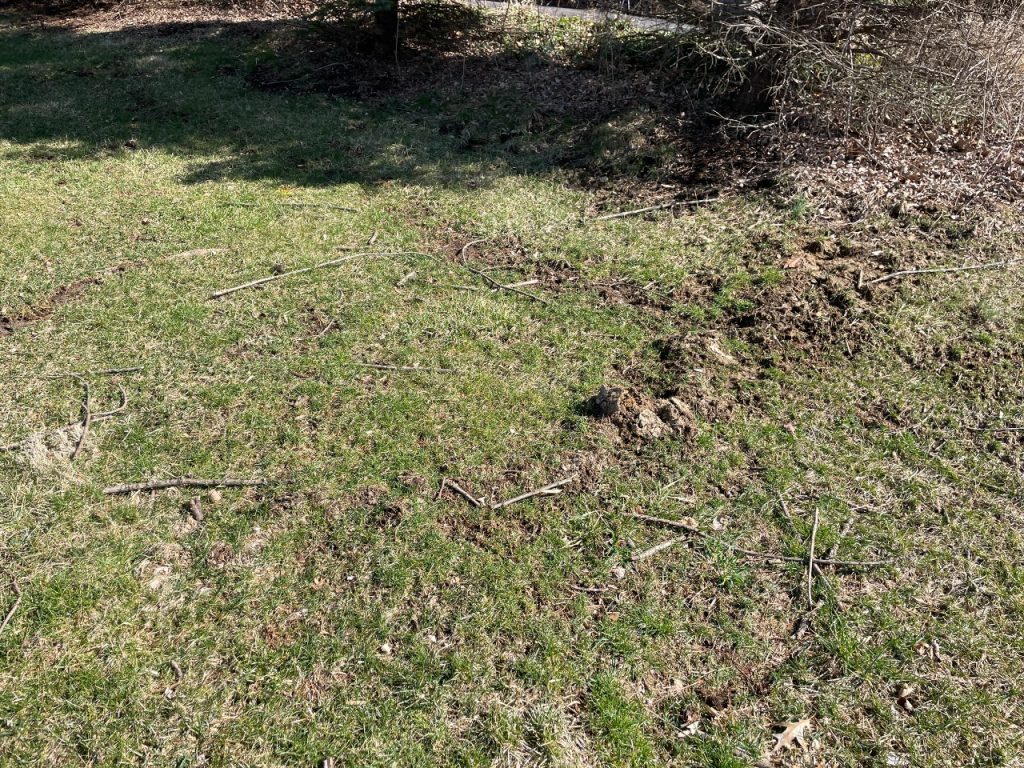When moles damage lawns, they become of great interest to homeowners. Understanding moles are key to controlling them. Listed below are mole facts regarding the habits, diet, and control of moles in the lawn and landscape.
General Information

-
- Adult moles are approximately 5-7 in length, have a hairless, pointed snout, and weigh about three to five ounces. They have paddle-shaped feet, suitable for digging in all types of soil.
- Moles may appear to be blind. Their eyes are covered by fur.
- The gestation period of moles is approximately 42 days.
- A female mole produces 2-6 young per litter in the spring.
- The mole’s den is located 12 to 18 inches below the surface and consists of irregular chambers about the size of a quart jar. They construct both deep and shallow tunnels. The tunnels seen at the surface are only part of a connected tunnel system.

Mole Habits
- Moles don’t hibernate. In the winter, they go deeper when the ground is frozen. In the Cincinnati area, the ground is not frozen for most of the winter.
- Moles can enter the property throughout the year, even after the property has been mole-free for some time.
- Moles do not create “holes.” Instead, construct tunnels and mounds in the yard and landscape, causing lawn damage by pushing up the soil.
- Moles mate in the spring. Employing mole control in the winter is a great idea because if the mole dies in the winter, it won’t mate in the spring. According to our experience and research, dead moles cannot reproduce.
- Moles are active throughout the year. Mole activity near the surface is less prominent during when the ground is frozen at the surface or during periods of extreme cold, heat, or drought. Moles are more active near the surface after rainfall or watering.
- Moles are solitary creatures that come together only to breed. After they leave the den, they spend their lives alone and are very competitive.
- Moles rarely come to the surface. When they do, it is usually by accident, as they prefer to stay beneath the surface, unexposed to the elements.

Moles create tunnels underground, about 1.5-2 inches in diameter. Some tunnels are deeper, while others are closer to the surface, where they push up the soil, causing frustration for homeowners.
Mole Diet
- Moles are “insectivores,” not rodents. However, while they eat insects (such as ants and grubs), their main diet is earthworms.
- Moles primarily eat earthworms. Moles are also known to eat white grubs and other insects, but the vast majority of their diet consists of juicy, delicious earthworms.
- Moles rarely consume roots, bulbs, and other plant material. Rodent such as voles and deer mice are usually the culprit when damaging plants.
- Moles consume 70 to 100 percent of their weight each day. They need that much food to produce energy since they spend ample time burrowing beneath the surface.
Controlling Moles in the Lawn and Landscape

-
- The key to controlling moles is to identify active mole tunnels. Moles create both active (tunnels they use over and over again) and probing (tunnels they create and rarely re-enter) tunnels throughout the yard.
- Before employing mole control, first stomp down all the mole tunnels. Check the tunnels after a couple of days to see which tunnels have popped back up. Then you will know which tunnels are active.
- The best methods of mole control is trapping and baiting. When baiting, use only bait that mimics the natural food source of moles – the earthworm. The active ingredient bromethalin, which is effective.
- Electronic devices placed in the lawn have been proven ineffective in controlling moles. Trapping and only certain baiting products/methods should be used for controlling moles.
- Repellants are ineffective against controlling moles.

Damage Caused By Moles

- Moles live almost underground, creating a vast network of interconnecting tunnels. While much of their tunnel system is well below the surface, they frequently create tunnels just below the surface where they cause visible damage to the lawn and landscape.
- If you have holes in your lawn and landscape, the offender is typically a rodent such as a groundhog (larger holes), chipmunk, mouse or vole. Moles do not create holes that expose them to the elements above ground.
- Mole mounds are formed when moles push up soil to the surface from underground runways. When moles tunnel deeper under the surface, they excavate the tunnels by pushing the dirt up to the surface, creating tunnels so they can move about more easily.
Help and Information
Need professional help controlling moles? Flying Pig Pest Control has decades of experience controlling moles. Begin here:
Mole Damage in Lawns – What to Look For – Check out this article to help identify mole damage in the lawn and landscape. This article with a video will help any homeowner who has questions when trying to identify the presence of moles in the lawn and landscape.
Live in the Cincinnati Ohio area and need help controlling moles? We can help!
For more information about moles, check out these external resources:
Effective Mole Control – Ohio State University Extension
Moles – PennState Extension
Controlling Nuisance Moles – University of Missouri
Moles and Their Control – University of Nebraska Neb Guide
How to Tell the Difference Between Moles and Voles – Clemson Cooperative Extension





